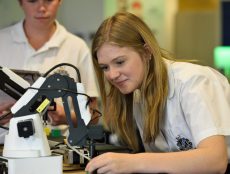
Larry R. MacPhee is the Associate Director of the eLearning Center at Northern Arizona University and has been working in the educational technology field since the early 2000s. In this week’s interview, eLearning Inside News talks to MacPhee about his work at NAU, and his insights on the evolution of eLearning and educational technologies over the past two decades.
From Satellite Campuses to eLearning
Cait Etherington: When did you first start to work in the eLearning field and what was the focus of your work at the time?
Larry R. MacPhee: I started out in Educational Technology Support, and later took leadership of the group called CTEL (the Center for Technology Enhanced Learning) at Northern Arizona University (NAU) back in 2001. Our main work was web course development. Before web-based courses, NAU’s Distance Learning group had the mission of delivering on-site courses at a collection of satellite campuses around the state, many in remote areas like the Navajo reservation and rural Arizona. The Distance Learning people were also pioneers in two-way Instructional Television, where the instructor was generally here at the Mountain Campus and students were attending from one of these satellite campus studios. However, ITV was expensive and required a lot of technical support, so the web became a way to continue to deliver distance courses at a lower cost.
The Evolution of eLearning since the Early 2000s
CE: How was eLearning delivered back in the early 2000s?
LRM: In the early 2000s, we used home-grown tools (a thing called “Web Wizard” that converted text to HTML) and a locally managed Virtual Conference Center (similar to an electronic bulletin board) for asynchronous group communication. Around the time I took over, we adopted Web Course Tools

(WebCT), an early commercial Learning Management System that was spun off from one of the better home grown tools developed by the University of British Columbia, in Canada. My office was a production house that consulted with faculty, got their course materials, and then built the courses for them. That worked well for several years but, as demand outstripped capacity, we were unable to scale, so we adopted the more full featured WebCT Campus Edition, and began to teach faculty HTML so they could build it themselves rather than have us build it for them. That changed our group from a production house into more of a consulting and tech support group, and allowed us to scale up course development by a factor of 5. We later transitioned to WebCT Vista, and continued to scale up as the tools got easier to use. When WebCT (the company) was bought by Blackboard, we transitioned to the Blackboard LMS. Blackboard allowed us to scale up again, because it did not require instructors to learn HTML, and provided all of the interactive tools needed to teach a fully online course.
CE: What major changes happened to eLearning in the mid 2000s?
CE: So you evolved from basically building course sites to helping students and faculty use available technologies and templates more effectively. What is the main focus of your work now?
LRM: I am now the associate Director of e-Learning at NAU, a group with a larger scope than the original CTEL office, and which includes assessment, research, effective instruction and faculty development in addition to instructional technology support. We seem to be on the verge of expanding again soon, as personalized learning tools, adaptive courseware, and publisher content are getting more sophisticated and moving beyond the LMS. Our main challenge today is to work with faculty to help them think about effective Instructional Design. In other words, let’s not just adopt a technology because we have it, but rather think about the problem we’re trying to solve and see if there’s a technology or a teaching practice that can help to achieve the desired outcomes.
Technology does change the way we teach, and done well, it can be highly rewarding. Used incorrectly though, it can create a huge mess. We’re also doing more without technology. We firmly believe that there are many ways to teach well, so we work to help good lecturers become better lecturers, and help instructors doing collaborative learning or blended learning do it more effectively.
Changing Attitudes towards eLearning
CE: How have attitudes towards e-Learning changed over the past two decades? What has been the most notable change?
LRM: It is becoming more widely accepted that technology as a teaching tool is not just here to stay, but is an essential component of instruction that allows us to be more efficient, engaging, and effective, even as enrollment and class sizes grow. Distance Learning used to be a side-mission of the university and was separate from that of in-person teaching and learning on the main campus, and the technology was, originally, mostly used for that purpose. Over the years, the technology has crept into all aspects of instruction, and there is much less of a distinction between a distance course and an in-person course. In-person courses can be technology enhanced, blended or hybrid, and distance courses can have synchronous (live) and collaborative components with lots of interaction between students and with the instructor.
Future Developments in the Evolution of eLearning
 CE: How do you think e-Learning will evolve over the next decade? For example, do you think that emerging applications in augmented reality will finally take off?
CE: How do you think e-Learning will evolve over the next decade? For example, do you think that emerging applications in augmented reality will finally take off?
LRM: That’s a tough question. Technology leaders generally fail to anticipate the big leaps. I expect continued disruptive change. None of the tech giants, like Microsoft, saw the Internet coming. None of the Internet giants, like Google, saw Social Software coming. There is little innovation in the LMS, despite the desperate need for better tools. Computers have stagnated, and most of the innovation has shifted to handheld portable touchscreen devices that I personally find somewhat limited. Between fear of missing out, and the always connected device, we will struggle more with distraction and continuous partial attention, with the blurring of work and personal time, and we suffer from a lack of quiet, and time for reflection. I have a gut feeling that these are not good things for the developing mind. They are appealing in the short term, like a sugar rush, but leave you tired and unfulfilled. I think augmented reality will detach us even more from the “real world” and further distract us from the here and now, but that doesn’t mean it isn’t coming. I just worry about people walking around campus oblivious to their surroundings, staring down at their phones while crossing the street, and having restaurant IM conversations with people not present instead of engaging with the person at the table.
CE: What about the IoT? Will learning increasingly become embedded in our environments and if so, what possible applications will this open up?
LRM: We are still in the early days of the Internet of Things. My biggest concern at present is the growing dependency on connected devices that can be hacked. Do we really need smart door locks or a refrigerator that tells us we need to buy milk? What if these things get hacked? How often do these devices need to be replaced? My own experience with things like smart thermostats is that they are fine when they work, but they add a lot of complexity and only a little value. I see that some of the new approaches in Biology teaching, like Project NANSLO, involve allowing students to connect to expensive devices remotely in order to do a lab, or in doing online simulations of a lab instead of the real thing. My own approach is the opposite. I want the students to go offline, conduct simple, hands-on experiments in their kitchen or back yard, and then come back online to report out and share their findings.
CE: What past technological developments would you say failed to live up to their promise to transform education, or said another way, where has the evolution of eLearning broken down?
 LRM: There are no easy answers to transforming education. Most technologies don’t live up to the promises of the visionaries or the sales people. Technologies don’t transform education because they tend to put the cart before the horse. We need to think more about the problems we’re trying to solve, the outcomes we’re trying to achieve, and then consider whether a technology (or something else) can help. When people say we can transform education by putting the Internet in the Classroom, or by taking students on Virtual Reality expeditions, I always want to ask, “What is the problem you’re trying to solve?” Consider how much more fulfilling a trip to the seashore is compared to an online VR experience, no matter how high tech. Some more recent failed experiments along the road to educational transformation include Second Life, MOOCs, and iPads in the classroom. They fail because they get implemented with the hope that instructors will figure out something cool to do with them once they are in place, rather than because they were needed for a particular purpose. A high tech classroom is a big investment, but the technologies tend to be short-lived, prone to breakage, and often aren’t appropriately used, because one time monies are easy. Money for training, support, and maintenance isn’t nearly as sexy, and it’s a recurring cost.
LRM: There are no easy answers to transforming education. Most technologies don’t live up to the promises of the visionaries or the sales people. Technologies don’t transform education because they tend to put the cart before the horse. We need to think more about the problems we’re trying to solve, the outcomes we’re trying to achieve, and then consider whether a technology (or something else) can help. When people say we can transform education by putting the Internet in the Classroom, or by taking students on Virtual Reality expeditions, I always want to ask, “What is the problem you’re trying to solve?” Consider how much more fulfilling a trip to the seashore is compared to an online VR experience, no matter how high tech. Some more recent failed experiments along the road to educational transformation include Second Life, MOOCs, and iPads in the classroom. They fail because they get implemented with the hope that instructors will figure out something cool to do with them once they are in place, rather than because they were needed for a particular purpose. A high tech classroom is a big investment, but the technologies tend to be short-lived, prone to breakage, and often aren’t appropriately used, because one time monies are easy. Money for training, support, and maintenance isn’t nearly as sexy, and it’s a recurring cost.
CE: What projects or initiatives are you currently working on at NAU?
LRM: Adaptive Learning and Personalized Learning are taking up a lot of my time these days. This is really the answer to your previous question about where e-Learning is headed. It used to frustrate me that the publishers are mostly building their own content and assessment tools and using our LMS only as a pass-through. Now, though, I see that that this allows them to continue to innovate where the LMS vendors have left off. Adaptive Learning tools have a lot of potential. If they live up to it, they promise to analyze the areas where students have good prior knowledge and tailor the “learning pathway” to the needs of the individual learner. This radically shifts us from the idea of a group of learners covering the same content at the same pace, to an individualized approach where each student is moving forward at his/her own pace. When the individual student achieves a level of mastery, he/she “graduates” from that course, but not necessarily at the same time as others. For traditional universities, this breaks the mold of courses and semesters. Of course, all of this depends on the quality of the content and the ability of the learning analytics to do a good job figuring out what a student already knows, and needs to know. That’s something teachers do pretty well, and machines will continue to struggle with. Learning from an algorithm seems, to me, somewhat joyless. When the computer says, “Great work!” it doesn’t feel genuine, the way it does when an admired teacher recognizes your efforts. When you achieve a goal, the computer will just throw more work at you. Still, I can imagine a future where most of us will be taught by computer programs and only the privileged will have living teachers!
CE: If you could solve one e-Learning challenge or problem, what would it be?
LRM: If I could solve one problem, it would be to take the e- out of e-Learning, and focus on the learning. We know a lot about what works, but we tend to go for the quick or the flashy fix rather than the long term solution. We also tend to invest in stuff more than in people, with the false assumption that throwing one time monies at a promising technology will magically solve our problems. Technology can be a great tool, but the person using the tool needs to know what they are doing, and why they are doing it.









No Comments